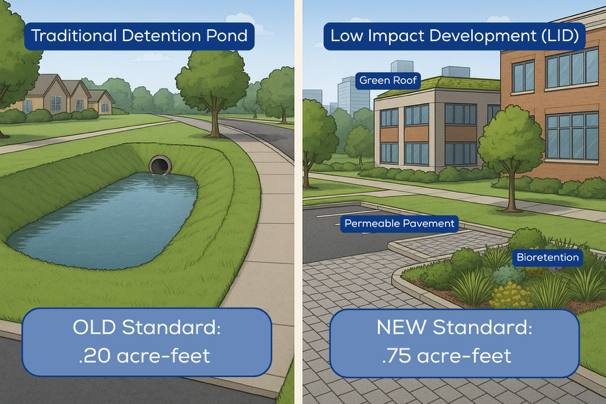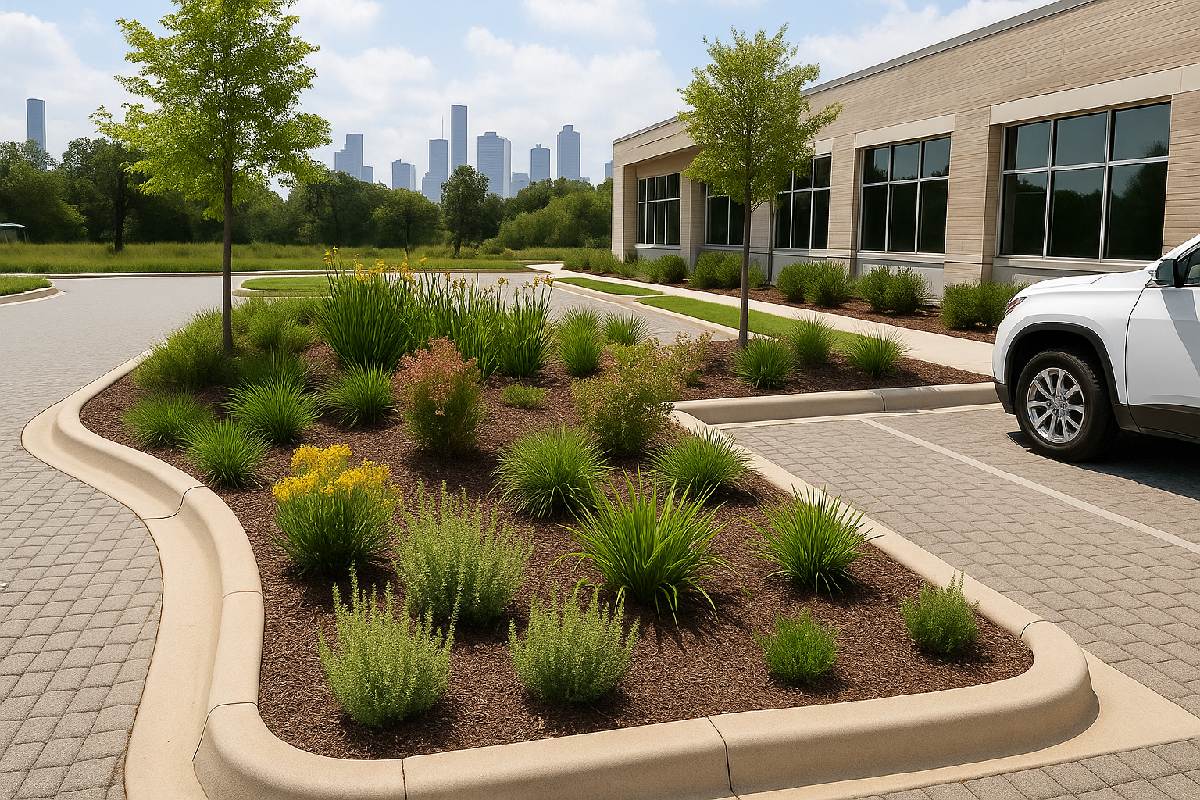A New Standard for Detention Volume

One of the most important updates is the increase in detention volume. Houston now requires most sites to detain 0.75 acre-feet of stormwater per acre of disturbed area. This is nearly four times the previous standard of 0.20 acre-feet. For sites under 20 acres, the City has simplified the requirements to a flat detention rate roughly 0.80 acre-feet per acre of new impervious cover. For larger projects, engineers must follow Harris County Flood Control criteria, which start at 0.65 acre-feet per acre and increase depending on the drainage study.
These new numbers change the way engineers must think about site layout, grading, and space allocation. What used to be a manageable part of a drainage plan is now a central design driver, especially on small and mid-sized infill sites.
LID Practices Are Now Officially Recognized
To meet these detention requirements, Houston encourages the use of approved Low Impact Development practices. This includes rain gardens, infiltration trenches, permeable pavements, bioswales, green roofs, rooftop detention systems, and rainwater harvesting systems like cisterns and rain barrels.

Each of these LID techniques must be backed by engineering calculations that prove their detention value. Additionally, the City requires a maintenance and life cycle plan, signed and sealed by a professional engineer, to ensure long-term performance.
These features are no longer just “add-ons” to check a sustainability box they’re now viable, often necessary, components of a compliant stormwater strategy.
What This Means for Engineers
The new standards demand early coordination between disciplines. Civil engineers will need to work closely with architects, landscape architects, and developers to integrate LID features into site design from the beginning. Bioretention areas may need to be placed in parking lot islands. Rooftop detention may influence roof slopes and structural loads. Rainwater harvesting systems may call for plumbing changes.
Engineers should also account for Houston’s challenging soil conditions. Many areas have clay-heavy soils with poor infiltration, which means underdrains or storage-based systems may be required. The Infrastructure Design Manual offers guidance on acceptable design approaches, and engineers should use real data like infiltration test results or drainage area calculations to support their plans.
The city’s permitting process now includes a more thorough review of detention and LID design. Drainage reports must clearly show how detention volumes are met, how LID features are sized, and how they will be maintained. If those pieces aren’t documented, the project won’t move forward.
Cost, Compliance and Oppurtunity
 While the increased detention volume can add cost and complexity, there are benefits to integrating LID early. These systems can reduce the need for large concrete ponds, improve site aesthetics, and offer long-term environmental gains. In some cases, they may also qualify for city incentives or help avoid costly redesigns during permit review.
While the increased detention volume can add cost and complexity, there are benefits to integrating LID early. These systems can reduce the need for large concrete ponds, improve site aesthetics, and offer long-term environmental gains. In some cases, they may also qualify for city incentives or help avoid costly redesigns during permit review.
Beyond compliance, LID techniques provide added value to property owners. Green infrastructure can support landscape design goals, reduce heat island effect, and improve water quality all of which are increasingly important to both regulators and communities.
Final Thoughts
Houston’s updated LID and detention requirements are a clear signal that the city is prioritizing flood resilience and sustainable development. For civil engineers, this means adjusting design approaches, collaborating across disciplines, and thinking creatively about how to manage stormwater within tighter site constraints.
Those who adapt early and use the city’s approved LID strategies will be best positioned to deliver high-quality, compliant, and forward-thinking projects in 2025 and beyond.
References & Resources:
- City of Houston Infrastructure Design Manual (2023 Edition & 2025 Chapter 9 Supplement) –Stormwater Design and Water Quality Requirements, Houston Public Works.
- Houston Permitting Center – Storm Detention Requirements – Frequently Asked Questions, rev. May 2025.
- H-GAC – Low Impact Development Toolbox (Techniques descriptions and maintenance guidelines)
